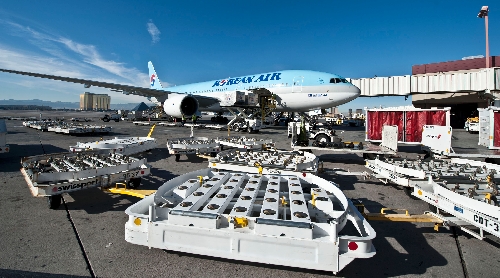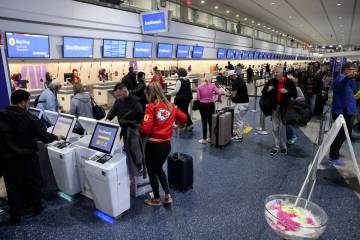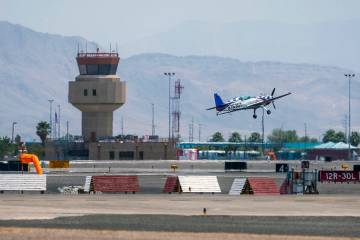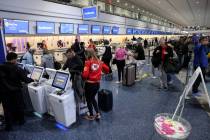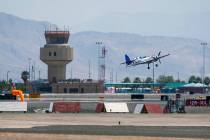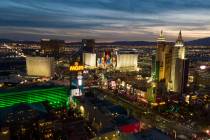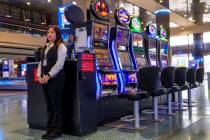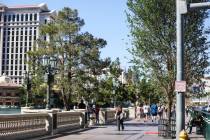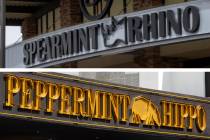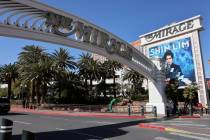Las Vegas aims to benefit from surge in foreign tourism
Mexican passengers stare out the tiny airplane window, watching as an expanse of desert appears beneath them. Shrouded in baby blue skies dotted with soft, white clouds, the 747 draws closer, passing over master-planned neighborhoods, all part of the city's larger grid pattern.
The international tourists stare as the landscape gives way to casinos. Closer now, they can see Mandalay Bay, Luxor, Excalibur, each in succession, unfolding in front of them as the city lays her hand at their feet.
Las Vegas is theirs for the taking, if only for a few days.
In 2010, 18 percent of the 37.3 million tourists who came to play in Las Vegas, or about 6.7 million people, experienced that arrival -- a significant increase in international tourist numbers from previous years. In 2007, it was 12 percent. In 2008, 15 percent, and in 2009, 14 percent.
The Las Vegas Convention and Visitors Authority wants more, and has set a goal of making international travelers 30 percent of the Las Vegas total.
Two very Vegas questions now come to mind: What are the odds, and what's the potential payout?
WILL THEY COME?
"I think that's doable," said Seyhmus Baloglu, professor and assistant dean for research and international programs for the University of Nevada, Las Vegas' William F. Harrah College of Hotel Administration.
Baloglu has taught destination marketing at UNLV since 1997 and has watched international visitation steadily grow over time.
Even the competition thinks Las Vegas can do it.
"I think it's an admirable goal. There's no reason they couldn't reach their goal," said Gary Sain, the CEO of Visit Orlando, the city of Orlando, Fla.'s tourism board.
So why target international tourism over other potential growth markets?
It's all in the numbers:
The average international traveler spends about $1,011 per stay and remains in the Las Vegas longer than four days each trip. Compare that with domestic tourists who spend $645 per visit on average and stay about three days.
"That's significant," said Michael Goldsmith, the authority's vice president of international sales.
When you consider that 95 percent of the world's population lives outside of the U.S., it makes perfect sense that international tourism holds great promise for any resort town.
"We know there's a tremendous amount of potential demand out there," said Rossi Ralenkotter, president and chief executive officer of the travel authority.
According to the U.S. Travel Association, international travel is already America's largest "export," representing 8.7 percent of U.S. exports of goods and services in 2010 and nearly a fourth of service exports. The travel industry's $134.4 billion in exports contributed more than any other industry to America's $1.8 trillion of total goods and service exports.
And it's a growing revenue source, not an industry where one resort town has to steal market share from another to boost numbers.
In 2010, 59.7 million international visitors arrived in the U.S., according to data from the Office of Travel & Tourism Industries, International Trade Administration, U.S. Department of Commerce. An expected 63.2 million foreign travelers were projected to have crossed into the U.S. in 2011, and 66.5 are expected to come in 2012.
In a report, the U.S. Department of Commerce projected the U.S. would see 5 percent annual growth rates in visitor volume throughout 2012-2016.
So what does Sin City have to do to secure its share of this bounty, and even bring in more?
First, we have to play the field.
About 70 percent of the city's international visitors now come from just three countries: the United Kingdom, Mexico and Canada. Authority officials say they'll have to draw traffic from more of the globe if they're to nearly double the flow.
That's because the countries that are the most likely to start flinging tourists into the world aren't on our list. Chinese tourism is expected to expand by 274 percent through 2016; Brazil, 135 percent; the Russian Federation, 131 percent; and Argentina, 70 percent.
How do we land more of those newly affluent international travelers?
First, we stop telling them they can't come here.
AN UNWELCOME RECEPTION
Citizens of the fast-growth counties run up against a heap of red tape that can sometimes prevent them from coming to America at all. Long waits for visitor visas -- in Brazil it can take up to 120 days, often requiring expensive travel to and from embassies and consulates -- can be a deterrent.
Ralenkotter and others are lobbying for expansion of the U.S. Department of State's visa waiver program, which allows certain international travelers to enter the county without a visa. Citizens of 36 countries who meet specific requirements are now eligible to travel to the U.S. for tourism or business as long as 90 days. Brazil, Russia, India and China, among other fast-growing sources of tourism, aren't included in the Visa Waiver Program.
"Brazil is a tremendous market for the United States. If we can get that opened up with a visa waiver, it'd be better," Ralenkotter said.
In his role as chairman of the Travel and Tourism board for the U.S. Department of Commerce, Ralenkotter submitted a report to Congress about what can be done to better welcome international visitors to the United States. Included was information about the U.S. visitor visa backlog.
Along with visa reform, the authority sees Brand USA, the federally mandated organization charged with promoting U.S. travel, as a step in the right direction. For the first time, the U.S. marketed itself as a whole, rather than leaving it up to states and individual cities.
"We've never been able to compete well on the global stage because Las Vegas has been competing with countries," Goldsmith said.
In late 2011 the convention authority's board of directors authorized a $100,000 expense to help fund the organization.
"The more international visitors we can get into the country, whether in Vegas or Orlando, it will help everybody," Sain said.
Besides aligning itself with Brand USA, the Las Vegas Convention and Visitors Authority has hired overseas marketing firms to campaign in 18 countries.
"They represent Las Vegas for us," said Goldsmith.
In Japan, for example, the authority is gathering data to determine what kind of ad campaigns are most effective for particular cultures -- Is Elvis the spokesman we need to get South Koreans to come our way while in Ireland they want to know that the Rat Pack is still on the job?
Answering those eternal questions is easier if you know the turf.
"They speak the language, literally and figuratively," Goldsmith said.
The tourism authority is also focusing international marketing efforts in three key areas: major, primary and emerging markets. Major markets are the U.K., Mexico and Canada, the countries considered "locked up," but still requiring attention to maintain strong relationships.
Primary markets include continental Europe, Japan and South Korea, which already provide a flow of tourists but could send still more.
Finally, the board sees the emerging markets of Brazil, Russia, India and China as the regions with the most untapped potential, as those relationships have yet to form in a substantial way.
UNLV's Baloglu said that if the authority wants to attract more international visitors, it has to research travelers' specific habits. It also has to understand what those travelers expect in service and entertainment, and then be ready to fulfill their needs.
TURNING BUSINESS INTO PLEASURE
The authority is also looking for ways to convert foreigners who come here for business -- usually trade shows and conventions -- into people who come here just for fun.
"Our business customer today is our leisure customer tomorrow," Goldsmith said.
Visit Orlando's Sain said that roughly 30 percent to 40 percent of business travelers come for business and stay for leisure.
While separate from the authority, Clark County's McCarran International Airport is expected to play a bigger role in that effort starting in June, when Terminal 3 will open. The new terminal will be able to accommodate as many as 53 million people per year, a net gain of about 5 million over current facilities.
The new terminal will also be far more efficient. Customs clearance requirements and physical constraints can nearly paralyze the antiquated Terminal 2, where no more than two planes can simultaneously arrive at four international gates.
At Terminal 3, 1,200 passengers, or three full 747s, will be able to simultaneously deplane through seven international gates. Meanwhile, customs and passport check areas will be bigger and nicer, with murals depicting all kinds of touristy things to do in and around Las Vegas.
Additionally, grander amenities including a steakhouse and high-end duty-free shopping will help enhance the airport experience, raising the comfort level and signaling to business travelers that Las Vegas is a place to revisit on their own time.
"Terminal 3 will give them amenities they've never had," said Rosemary Vassiliadis, deputy director of aviation for McCarran.
"The future looks very bright for international visitation," Goldsmith said hopefully.
Contact reporter Laura Carroll at
lcarroll@reviewjournal.com or 702-380-4588.




